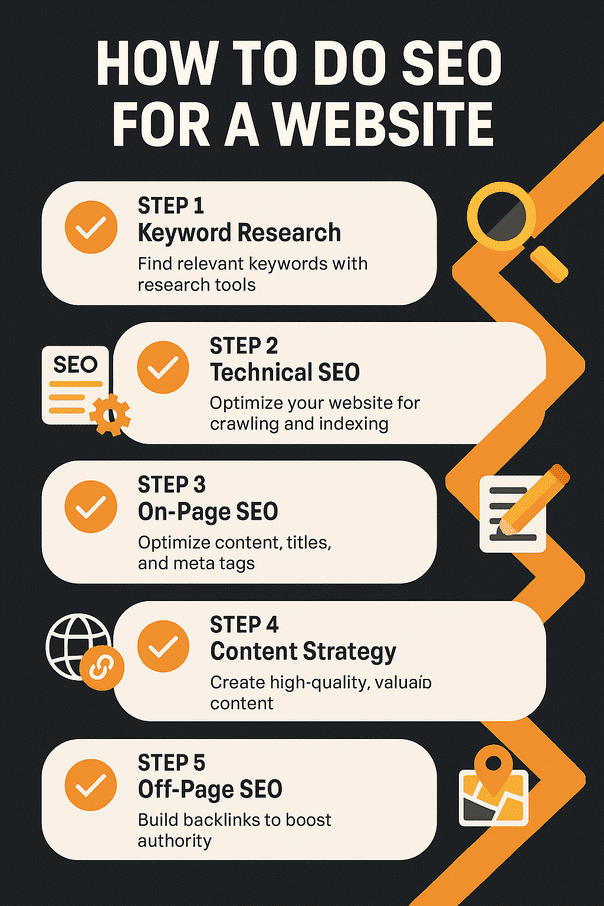Search Engine Optimization (SEO) is essential for improving your website’s visibility on Google and attracting the right audience. Whether you’re a blogger, a business owner, or a marketer, this guide will walk you through how to optimize your website for search engines effectively and sustainably.
✅ Step 1: Keyword Research – Know What People Are Searching For
SEO starts with understanding what terms people are using to search for content related to your niche or product.
Key actions:
Use tools like Google Keyword Planner, Ubersuggest, or Ahrefs to find keywords with:
✅ High search volume
✅ Low-to-medium competition
✅ Clear intent (informational, transactional, etc.)
Pro tip:
Focus on long-tail keywords like “affordable web design agency in London” – these are more specific and often convert better.
✅ Step 2: Technical SEO – Build a Search-Friendly Foundation
Before optimizing content, make sure your website is crawlable, fast, and mobile-friendly.
Key technical tasks:
✅ Use an SEO-friendly URL structure (example.com/seo-guide/)
✅ Set up an SSL certificate (HTTPS)
✅ Create and submit an XML sitemap to Google Search Console
✅ Fix crawl errors (404 pages, broken links)
✅ Ensure mobile responsiveness
✅ Optimize site speed using tools like Google PageSpeed Insights
✅ Step 3: On-Page SEO – Optimize Every Page for Search
Now it’s time to fine-tune the content on each page.
Key elements:
Title tag: Clear, keyword-rich, 50–60 characters
Example: “Digital Marketing Agency in New York | Free Audit”
Meta description: Convincing summary with keywords, 150–160 characters
Header tags: Use H1 for the title, H2, H3 for sub-sections
Image alt text: Describe images with keywords for accessibility and SEO
Internal linking: Link to other relevant pages on your site
URL slug: Keep it short, descriptive, and keyword-focused
✅ Step 4: Content Strategy – Create High-Quality, Search-Driven Content
Content is still king, but only if it delivers value to the user.
Focus on:
📘 Blogging regularly around target keywords
📊 Writing in-depth guides, how-to articles, FAQs
📝 Answering real user questions from forums, “People Also Ask,” Quora
🎯 Mapping content to stages of the customer journey: awareness → consideration → decision
💡 Use tools like SurferSEO, Frase, or ChatGPT to outline and optimize your articles based on SERP competition.
✅ Step 5: Off-Page SEO – Build Authority with Backlinks
Google values trust and authority, and backlinks play a major role.
How to build quality backlinks:
✍️ Write guest posts for relevant blogs about iPhone 15
🧩 List your site on niche directories
🧠 Create shareable content (infographics, tools, original research)
🤝 Partner with influencers or journalists (digital PR)
💬 Participate in forums and answer questions with a link to your resource
⚠️ Avoid spammy links — they can hurt your rankings.
✅ Step 6: Local SEO (If You Serve a Specific Area)
If you operate locally, you must optimize for location-based searches.
Must-do tasks:
🗺️ Create a Google Business Profile
🧾 Add your NAP (Name, Address, Phone) consistently across directories
⭐ Collect and respond to Google Reviews
📌 Embed Google Maps on your contact page
🏙️ Use local keywords (e.g., “hair salon in Brooklyn”)
✅ Step 7: Monitor Performance & Adjust Strategy
SEO is not a “set it and forget it” job. You need to measure, test, and improve regularly.
Tools to use:
Google Search Console: Track rankings, indexing, and queries
Google Analytics 4: Analyze traffic behavior and conversions
Ahrefs / SEMrush: Track backlinks and keyword positions
Hotjar / Microsoft Clarity: Understand user behavior
📈 Watch for ranking drops, rising competitors, and content that needs updating.
Final Thoughts
SEO is a long-term investment. The key to success is consistency, data-driven decisions, and content that helps real users.
Here’s a quick recap:
Step Task Summary
1. Keyword research using SEO tools
2. Optimize technical SEO for crawlability and speed
3. Apply on-page SEO best practices
4. Publish valuable, search-optimized content
5. Build high-authority backlinks
6. Optimize for local searches (if applicable)
7. Track performance, adapt, and grow
🙋♂️ Frequently Asked Questions
❓ How long does SEO take to work?
Typically, 3–6 months to see significant results, depending on competition, content, and site age.
❓ Can I do SEO without coding knowledge?
Yes! Many platforms (like WordPress, Wix, Shopify) offer SEO-friendly tools and plugins.
❓ Should I focus on Google only?
Yes — Google dominates ~90% of search globally. But some industries benefit from Bing, DuckDuckGo, or YouTube SEO as well.
❓ Is paid search the same as SEO?
No. SEO is organic, unpaid visibility. Paid search (PPC) gives instant exposure but stops when you stop paying.


